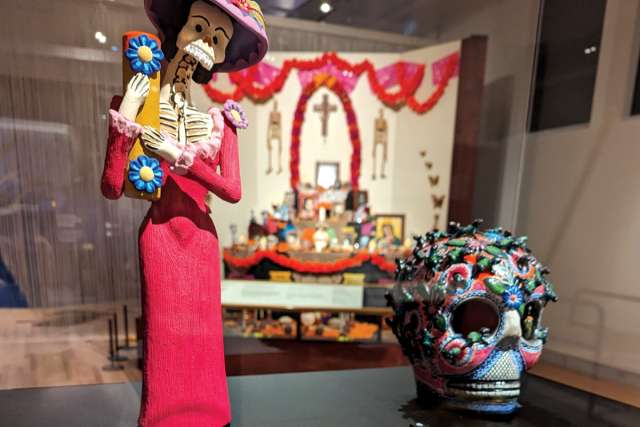With a rich collection of historic artifacts, intricate specimens and immersive media experiences, Death: Life’s Greatest Mystery aims to open up important conversations about the cycle of life and death. Visitors will learn about the commemoration of death across different cultures and how other life forms experience and challenge death.
“It’s something especially in a lot of European and North American cultures that it’s not really talked about. And so, here’s an opportunity to explore a little bit and demystify death,” said Juline Chevalier, ROM’s assistant vice president (Interpretation). “We hope the exhibition is a comfortable space to explore, that is an opportunity to maybe have discussions with friends or family that you haven’t had before.”
The exhibition — organized by Chicago’s Field Museum and running at the downtown Toronto museum through April 7 — is divided into multiple sections that ask important questions around life and death, namely: What is death? Do I have to die? What will happen to my body? What will happen to my spirit? How will my death affect others?
The Catechism of the Catholic Church tells us death is the end of earthly life (CCC 1007). The Christian perception is that life continues after death, the beginning of another existence either in Heaven or Hell.
Chevalier said many cultures believe in life after death. However, the exhibition will help visitors contemplate the differing perspectives across various cultures. These perspectives are often expressed through diverse rituals and cultural objects.
“So many celebrations of life or rituals around death involve food and serving and sometimes it is serving the family that is affected. But sometimes it’s the family that engages in serving others,” she said. “You know Day of the Dead and many Mexican cultures. It’s a day of, you know, sadness is part of it, but it’s a celebration. It’s an opportunity to remember and connect again with people who aren’t living.”
A prominent exhibit is an ofrenda (household memorial) by Chicago artist Norma Rios Sierra, for the Día de Los Muertos (Day of the Dead). Depicting members of her family, it adds a personal and intimate touch to the experience.
The exhibits include other pieces highlighting the rich diversity of cultural practices. A canoe-shaped Ghanaian fantasy coffin by Seth Kane Kwei depicts an integral part of the deceased person’s life. There are also ancient artefacts which delve into global cultural perspectives about death like Shabti molds and figurines from ancient Egypt, bronze statues from India and Daoist figures from China. Another notable piece is a Mola textile made by the Gula/Dule people, depicting the original sin, the fall of Adam and Eve.
There is also a profound interactive multi-sensory exhibit with interactive poll stations that ask visitors about their thoughts on matters of death.
Death: Life’s Greatest Mystery further makes one ponder that death is not solely a human experience. An impressive natural history section explores the myriad ways in which death is observed in the natural world. Elephants, whales, horses and other primates may also grieve at the loss of their own, while other species seldom pay heed to such losses. A life form of special significance is tardigrades (microscopic water bears). These organisms are capable of surviving extreme conditions, often going into long periods of stasis, which in turn raises the question of if stasis could be equated to death.
Chevalier said Death: Life’s Greatest Mystery really shows how people and other life forms come together celebrating death. Moreover, she believes it would aid families in having uncomfortable conversations about passing, especially with kids. She urges visitors to approach the exhibition with a sense of childlike curiosity.
“It’s an opportunity for families to have discussions,” Chevalier said. “I don’t know if you necessarily have to have childlike innocence but wonder and excitement about seeing something new and making sense of it yourself. That’s really something.”

